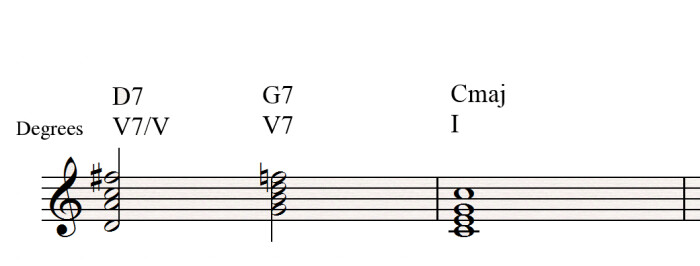In this installment, we'll continue exploring chord substitutions with two new forms based on the dominant function.
Tritone substitution
As usual, we’ll start by looking at the perfect cadence, which seems to have decidedly become the most crucial element in tonal music! We’ve mentioned many times before in this series that the perfect cadence implies a sense of resolution. This is created by the tension produced by the presence of the tritone in the dominant seventh chord (see article 9).
In the following example, the B-F tritone included in the G dominant seventh chord is also present in the Db dominant seventh chord.

Both chords feature the same tritone and they can be resolved in the same way, namely being followed by a C chord (major or minor) or a Gb chord (major or minor).

Like any other substitution, it should obviously be applied cautiously and depending on the overall context of the song.
An example where this substitution works particularly well is with the II-V-I cadence. In this case the V is substituted by the chord featuring the same tritone (bII7), which gives way to a chromatic progression on the bass. In this example it goes like this: D-Db-C. This is called a “dominant substitute” or “dominant substitution.” In the previous example, C#7 is the dominant substitute of G7. And it’s indicated as “subV7.” But be careful, dominant substitutes are not to be confused with the so-called secondary dominants, which we’ll discuss below.
Secondary dominants
By now you have surely realized how powerful the V-I resolution is. This “force” can be used to emphasize any given chord in a song. This can be easily achieved by preceding the chord you want to emphasize with the dominant chord of its own root scale. This is called a secondary dominant. And this, once again, highlights the importance of the circle of 5ths (see article 3), which easily allow you to determine the secondary dominants.
Thus, in the following example, D7 is the dominant of G7, which is in turn the dominant of Cmaj. D7 is hence a secondary dominant of the C major key. This is indicated as “V7/V, ” which stands for seventh dominant of the V degree of the key. In this case I intentionally put the F# of the D7 as the top voice so you can clearly hear the chromatic progression towards the F of the G7 chord.

Do note however, that in this particular case the D7 introduces a new note, a non-chord tone of the C major key, namely F#.
Under certain, very specific conditions, which I’ll discuss in detail in an upcoming article, the use of secondary dominants allows you to shift the key of the song by temporarily modifying its alterations. This is called “modulation.” You have probably noticed that, in the previous example, the roots of the chords used (D7, G7 and Cmaj) correspond to the roots of the II-V-I progression (Dmin7, G7 and Cmaj) indicated in the previous article. The secondary dominant could just as easily replace the II degree in this progression:

We’ll talk a bit more about chord substitutions in the next article, so stay tuned!






